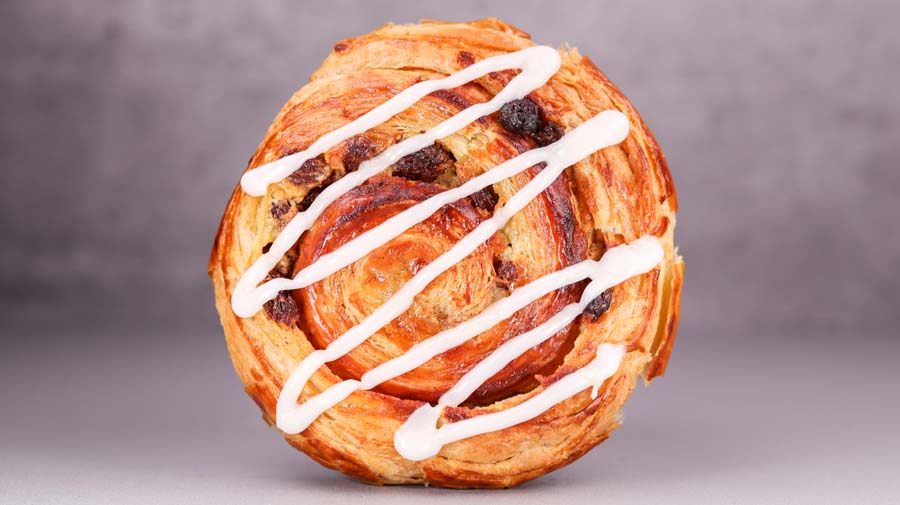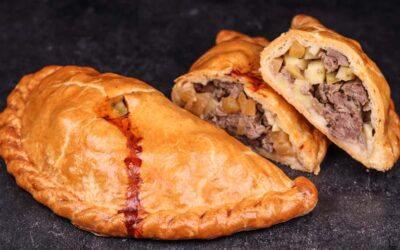Pain aux raisins is a custard and raisin filled pastry usually made with laminated leavened dough like the one used for croissants. It is sweet, moist, flaky, and incredibly delicious. Croissant dough is not easy to make by hand. But when we use the rough laminated dough method it becomes totally attainable.
I am using a similar dough to the one I used for kouign-amann a couple of videos back. As soon as I finished recording that video, I knew I must make something else using this dough. Because the butter is grated rather than flattened and added in one piece, we don’t need to worry about it breaking up when we roll it since it’s already broken. The hydration is lower here to make it easier to handle, so if you were unsure previously, then this may be a good starting point.
This recipe makes 6 huge pain aux raisins or more smaller ones. Divide it how you like it.
Watch the video down below for detailed instructions.
Ingredients
For the dough –
250g (8.8oz) white bread flour
3g (0.1oz) instant dry yeast or 3.6g (0.13oz) active dry yeast or 9g (0.32oz) fresh yeast
4g (0.14oz) salt
20g (0.7oz) sugar
25g (0.9oz) melted butter
150g (5.3oz) water*
2 x 100g (2 x 3.5oz) frozen butter for the layers
1 egg for glazing before baking
For the custard –
200g (7oz) milk
50g (1.75oz) sugar
25g (0.9oz) butter
1 egg (50g, 1.75oz)
6g (0.21oz) vanilla paste
20g (0.7oz) cornstarch
For the raisins –
100g (3.5oz) raisins
2g (0.07oz) cinnamon
1 orange worth of zest
½ orange juice
For the icing –
80g (2.8oz) icing sugar
13g (0.45oz) orange juice
Mix together until smooth.
*To learn more about no-knead bread dough temperature control click here.
The flour I use has a protein content of 13%. If your flour is weaker, then you may need to lower the hydration.
If you are using active dry yeast, then you may need to let it sit in the water for 10 minutes before adding the other ingredients or else it could take a lot longer to raise the dough.
If you are curious about why the dough contains butter, egg, and sugar, click the links to learn more about the effects those ingredients have on bread dough.
Method
- Soak the raisins. Combine the raisins, cinnamon, orange zest, and orange juice. Mix and leave on the side. Mix one or two more times afterwards to ensure all the juice is absorbed.
- Make the custard. Combine all the ingredients in a pan and set it on medium-high heat. Cook while whisking continuously for 3 – 4 minutes or until thickened. Transfer to a bowl, cover with clingfilm so that it’s touching the surface. Refrigerate until needed.
- Make the dough. Combine the water, yeast, salt, sugar, and melted butter. Mix well to dissolve the salt and sugar, and to hydrate the yeast. Add the flour and mix to a dough. *Desired dough temperature 24C (75F).
- Cover and ferment for 20 minutes.
- Fold #1.
- Ferment for 20 minutes.
- Fold #2.
- Ferment for 20 minutes.
- Roll the dough out to a large rectangle. Grate one of the butter pieces evenly all over the surface. Fold the dough into three layers.
- Cover and refrigerate for 30 minutes.
- Roll the sough out to a large rectangle once again. Grate the second piece of butter and repeat the same fold as previously. Repeat the rolling and folding two more times.
- Cover and refrigerate for at least 1 hour.
- Shape the pastries. Roll the dough out to a large rectangle once again. Place it vertically in front of you. Spread the custard evenly leaving a little edge at the top. Sprinkle the raisins over the custard.
- Brush the exposed edge of dough with water to make it sticky. Roll it up as evenly as you can.
- Trim the ends (optional) and cut the roll into as many pieces as you like.
- Place on a non-stick paper lined baking tray.
- Final proof for 1.5 – 2 hours.
- Brush generously with egg.
- Bake at 170C (340F) fan on for around 25 minutes until the pastries are golden brown all over.
- Leave to cool down completely. Decorate with the icing and tuck in!
Keep in mind that the conditions in each kitchen are different, so fermentation times may vary for you. It is up to the baker to control the bread and react accordingly.
Your oven may be different too, so your baking time may vary.



